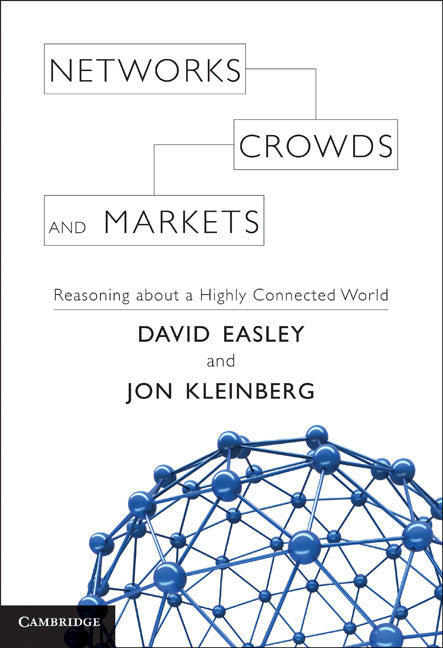Freshly Printed - allow 8 days lead
Couldn't load pickup availability
Networks, Crowds, and Markets
Reasoning about a Highly Connected World
Reveals the interdisciplinary field of networks, which changes how we look at social, financial and technological interactions in modern society.
David Easley (Author), Jon Kleinberg (Author)
9780521195331, Cambridge University Press
Hardback, published 19 July 2010
744 pages, 332 b/w illus. 128 exercises
26.4 x 19 x 3 cm, 1.31 kg
'Easley, an economist, and Kleinberg, a computer scientist, accomplish the difficult task of making the subject available to students from basically any field without being superficial. Their text was designed as transdisciplinary from the start and will be specifically interesting to physics students who pursue an interdisciplinary career geared toward the social science and econophysics.' Physics Today
Are all film stars linked to Kevin Bacon? Why do the stock markets rise and fall sharply on the strength of a vague rumour? How does gossip spread so quickly? Are we all related through six degrees of separation? There is a growing awareness of the complex networks that pervade modern society. We see them in the rapid growth of the internet, the ease of global communication, the swift spread of news and information, and in the way epidemics and financial crises develop with startling speed and intensity. This introductory book on the new science of networks takes an interdisciplinary approach, using economics, sociology, computing, information science and applied mathematics to address fundamental questions about the links that connect us, and the ways that our decisions can have consequences for others.
1. Overview
Part I. Graph Theory and Social Networks: 2. Graphs
3. Strong and weak ties
4. Networks in their surrounding contexts
5. Positive and negative relationships
Part II. Game Theory: 6. Games
7. Evolutionary game theory
8. Modeling network traffic using game theory
9. Auctions
Part III. Markets and Strategic Interaction in Networks: 10. Matching markets
11. Network models of markets with intermediaries
12. Bargaining and power in networks
Part IV. Information Networks and the World Wide Web: 13. The structure of the Web
14. Link analysis and Web search
15. Sponsored search markets
Part V. Network Dynamics: Population Models: 16. Information cascades
17. Network effects
18. Power laws and rich-get-richer phenomena
Part VI. Network Dynamics: Structural Models: 19. Cascading behavior in networks
20. The small-world phenomenon
21. Epidemics
Part VII. Institutions and Aggregate Behavior: 22. Markets and information
23. Voting
24. Property.
Subject Areas: Computer networking & communications [UT], Databases & the Web [UNN], Algorithms & data structures [UMB], E-commerce: business aspects [KJE], Behavioural economics [KCK], Social theory [JHBA]


